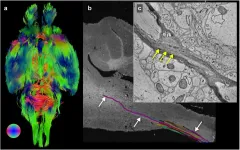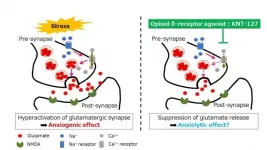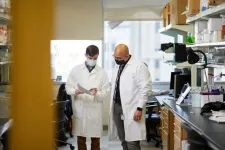(Press-News.org) PITTSBURGH, June 28, 2021 - It was a nagging mystery: A rare-disease expert at UPMC Children's Hospital of Pittsburgh had found a successful treatment for two of the deadliest symptoms of one of the more common classes of rare diseases diagnosed by newborn screenings, but one symptom--painful episodes of muscle breakdown that land victims in intensive care--persisted.
Today, the scientists announce in the journal Clinical & Translational Immunology that they've gotten to the bottom of the self-destructive syndrome and have a good lead on a treatment.
"These episodes looked a lot like inflammatory muscle disease, but usually that is persistent and doesn't wax and wane, so it wasn't a perfect fit," said senior author Jerry Vockley, M.D., Ph.D., chief of Genetic and Genomic Medicine and director of the Center for Rare Disease Therapy at UPMC Children's and professor of pediatrics and human genetics at the University of Pittsburgh School of the Health Sciences. "Still, I couldn't shake the thought that there was some inflammatory link, so we tested patient blood samples. Sure enough, when the episodes were happening, certain inflammatory markers were high, and when the patients were well, they were lower. Knowing this will allow us to try to figure out why this inflammation is happening and prevent it."
Very long chain acyl-CoA dehydrogenase deficiency--VLCADD--is a genetic disease where a mutation prevents an enzyme from breaking down fatty acids into energy. It afflicts about one in 40,000 people but is part of a class of diseases that affect four times that number, making it one of the more common of the rare genetic diseases that U.S. doctors now universally test for in newborns.
If untreated, the disease can cause heart failure and low blood sugar--two life-threatening conditions. When coupled with a modified diet, a recently approved drug that Vockley was involved in developing can manage those symptoms. But patients still experience rhabdomyolysis--muscle breakdown--indicating that the disease acts through another pathway.
With his hunch that inflammation might be behind the rhabdomyolysis, Vockley consulted with Abbe de Vallejo, Ph.D., associate professor of pediatrics, immunology and rheumatology in Pitt's School of Medicine and director of the Flow Cytometry Core Facility at the John G. Rangos Sr. Research Center located at UPMC Children's.
Their teams tested patient blood samples that Vockley had stored from his previous research and obtained additional samples from new patients. One patient--Bella Linz, 15, of Meadville, Pa.--had particularly persistent bouts of rhabdomyolysis requiring week-long hospitalizations more than a dozen times per year. She consented to give blood samples over several years and participate in the study. Regular infusions of an anti-inflammatory medication kept her from needing to be hospitalized for nearly 10 months, and then only irregularly since.
"Bella is a very empathetic child, very caring," said her mother, Carrie Linz. "So, when she was going through trying out the different medications and the pain that came with the shots, we'd talk about the other children this would help--how what she was doing would benefit other kids, quicker and for a longer period of time. That helped us find purpose."
The team found that when the patients were experiencing episodes of rhabdomyolysis, they were having what's known as a "cytokine storm"--when various inflammatory molecules are produced by immune cells in excessive quantities, leading them to attack the body. Even when they weren't having these episodes, the patients had elevated inflammatory markers, though at lower numbers than when they were symptomatic.
Still, the solution isn't so clear-cut, de Vallejo said.
"The cytokines activate cells, but those cells aren't following the rules," he said. "In the immune system, cytokines and cells 'talk' to each other to regulate and counter-regulate their actions accordingly. But that's not happening the way you'd expect in VLCADD patients. It's paradoxical and is our next challenge. If we can find the disconnect, we may be able to learn what is triggering the inflammatory response and stop it from happening altogether."
In the meantime, the team also is exploring the off-label and compassionate use of certain anti-inflammatory medications to treat acute, symptomatic rhabdomyolysis and prevent it from occurring.
INFORMATION:
Additional authors on this research are Henry J. Mroczkowski, M.D., Ph.D., Joshua J. Michel, Michael Woolford, Harry C. Blair, M.D., Patricia Griffin, Elizabeth McCracken, M.S., C.G.C., Stephanie J. Mihalik, Ph.D., and Miguiel Reyes-Mugica, M.D., all of Pitt at the time of the research.
This research was funded by National Institutes of Health grant R01 DK78755 and an IRG Award from the Nancy E. Taylor Foundation for Chronic Diseases Inc.
To read this release online or share it, visit http://www.upmc.com/media/news/062821-deVallejo-VLCADD-CTI.
About the University of Pittsburgh Schools of the Health Sciences
The University of Pittsburgh Schools of the Health Sciences include the schools of Medicine, Nursing, Dental Medicine, Pharmacy, Health and Rehabilitation Sciences and the Graduate School of Public Health. The schools serve as the academic partner to the UPMC (University of Pittsburgh Medical Center). Together, their combined mission is to train tomorrow's health care specialists and biomedical scientists, engage in groundbreaking research that will advance understanding of the causes and treatments of disease and participate in the delivery of outstanding patient care. Since 1998, Pitt and its affiliated university faculty have ranked among the top 10 educational institutions in grant support from the National Institutes of Health. For additional information about the Schools of the Health Sciences, please visit http://www.health.pitt.edu.
About UPMC Children's Hospital of Pittsburgh
Regionally, nationally, and globally, UPMC Children's Hospital of Pittsburgh is a leader in the treatment of childhood conditions and diseases, a pioneer in the development of new and improved therapies, and a top educator of the next generation of pediatricians and pediatric subspecialists. With generous community support, UPMC Children's Hospital has fulfilled this mission since its founding in 1890. UPMC Children's is recognized consistently for its clinical, research, educational, and advocacy-related accomplishments, including ranking in the top 10 on the 2021-2022 U.S. News Honor Roll of America's Best Children's Hospitals. UPMC Children's also ranks 15th among children's hospitals and schools of medicine in funding for pediatric research provided by the National Institutes of Health (FY2019).
http://www.upmc.com/media
Contact: Allison Hydzik
Office: 412-647-9975
Mobile: 412-559-2431
E-mail: HydzikAM@upmc.edu
Contact: Andrea Kunicky
Office: 412-692-6254
Mobile: 412-552-7448
E-mail: KunickyA@upmc.edu
An incredibly rare hybrid warbler with mismatched color patterns has allowed researchers to disentangle the genetic drivers of two traits that usually come as a package deal--the black face mask and the black throat patch in blue-winged and golden-winged warblers. A new study describing the peculiar bird and pinpointing the location in the genome that controls the face mask and throat patch appears online in the journal Ecology.
"Golden-winged warblers have both a black face mask and a black throat patch, while blue-winged warblers have neither," said Marcella Baiz, postdoctoral researcher at Penn State and first ...
Some exoplanet searches could be missing nearly half of the Earth-sized planets around other stars. New findings from a team using the international Gemini Observatory and the WIYN 3.5-meter Telescope at Kitt Peak National Observatory suggest that Earth-sized worlds could be lurking undiscovered in binary star systems, hidden in the glare of their parent stars. As roughly half of all stars are in binary systems, this means that astronomers could be missing many Earth-sized worlds.
Earth-sized planets may be much more common than previously realized. Astronomers working at NASA Ames Research Center have used the twin telescopes of the international Gemini Observatory, a Program of NSF's NOIRLab, to determine that many planet-hosting ...
WASHINGTON, D.C.--A new study in Annals of Emergency Medicine highlights the importance of protecting physician residents--early-career doctors still in training--and emergency care teams from incidents of physical or verbal abuse.
The survey of 123 physicians, residents, and staff in one emergency department found that 78 percent of all health care workers experienced a violent assault in the prior 12 months, including more than one in five (22 percent) emergency physician residents. Eighty-nine percent of residents experienced verbal assault by a patient in the prior 12 months, compared to 80 percent of other health care workers.
"Violent ...
Philadelphia, June 28, 2021--Researchers at Children's Hospital of Philadelphia (CHOP) have discovered that a specific type of lung cell exhibits unconventional immune properties and may contribute to the outcome of respiratory viral infections. The researchers focused on type II alveolar (AT2) cells, which are non-immune cells of the lung that are critical for basic lung health and tissue repair after lung injury. They found that AT2 cells express high levels of major histocompatibility complex II (MHC-II), an important immune system trigger, and that AT2 MHC-II expression appears to confer an appreciable ...
Researchers at the University of Chicago and the U.S. Department of Energy's (DOE) Argonne National Laboratory have leveraged existing advanced X-ray microscopy techniques to bridge the gap between MRI (magnetic resonance imaging) and electron microscopy imaging, providing a viable pipeline for multiscale whole brain imaging within the same brain. The proof-of-concept demonstration involved imaging an entire mouse brain across five orders of magnitude of resolution, a step which researchers say will better connect existing imaging approaches and uncover new details about the structure of the brain.
The advance, which was published on June 9 in NeuroImage, will allow ...
As social media and other online networking sites have grown in usage, so too has trolling - an internet practice in which users intentionally seek to draw others into pointless and, at times, uncivil conversations.
New research from Brigham Young University recently published in the journal of Social Media and Society sheds light on the motives and personality characteristics of internet trolls.
Through an online survey completed by over 400 Reddit users, the study found that individuals with dark triad personality traits (narcissism, Machiavellianism, psychopathy) combined with schadenfreude - a German word meaning that one derives pleasure from another's misfortune - were more likely to demonstrate trolling behaviors.
"People who exhibit ...
A discovery by a team of researchers, led by a Geisinger professor, could yield a potential new treatment for breast cancer.
In a study published this month in Cell Reports, the team used small molecules known as peptides to disrupt a complex of two proteins, RBM39 and MLL1, that is found in breast cancer cells but not in normal cells.
The research team discovered that the abnormal interaction between RBM39 and MLL1 is required for breast cancer cells to multiply and survive. The team developed non-toxic peptides that prevent these proteins from interacting in breast cancer cells, disrupting their growth and survival.
"Because these proteins do not interact in normal ...
Anxiety, commonly termed as a feeling of fear, dread, and restlessness, is a perfectly normal reaction to stressful situations. However, a state of heightened anxiety, which is the reality for thousands of people who struggle to cope with these feelings, is called anxiety disorder. Anxiety disorder can invoke debilitating fear or apprehension, even without any immediate threat. Though intensive research over the years has yielded a plethora of information, and effective drugs like selective serotonin reuptake inhibitors have been used to alleviate this condition, a lot remains to be understood about this complex condition and ...
The first two COVID-19 vaccines authorized for emergency use by the Food and Drug Administration (FDA) employed a technology that had never before been used in FDA-approved vaccines. Both vaccines performed well in clinical trials, and both have been widely credited with reducing disease, but concerns remain over how long immunity induced by the new vaccine technology will last.
Now, a study from researchers at Washington University School of Medicine in St. Louis, published June 28 in the journal Nature, has found evidence that the immune response to such vaccines is both strong and potentially long-lasting. Nearly four months after the first dose, people who received the Pfizer vaccine still had so-called germinal centers in their lymph nodes churning out ...
The use of transparent masks during communication increases comprehension of speech by about 10% for people with hearing loss and people with normal hearing, according to a study published in the journal Ear and Hearing.
The study was conducted at the University of Texas in Dallas (USA), with the participation of Regina Tangerino, a professor at the University of São Paulo's Bauru Dental School (FOB-USP) in Brazil, and with support from São Paulo Research Foundation - FAPESP.
"Our findings show that wearing a transparent mask can facilitate communication for everyone, ...


